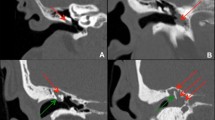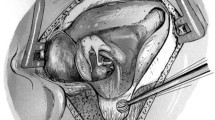Abstract
To compare pediatric and adult patients, affected by cholesteatoma for the clinical presentation, disease extent and final outcome. This is a prospective study in which 60 cases of unsafe chronic suppurative otitis media with cholesteatoma were included. These cases were divided into two groups of 30 cases each on the basis of age. All patients were subjected to detailed clinical examination. A high resolution computed tomography of the temporal bone was done in all the cases. An innovative grading system was devised to grade the disease. The patients were subjected to canal wall down mastoidectomy and were evaluated postoperatively for resolution of the symptoms, hearing and cavity problems. Granulation tissue along with cholesteatoma was more common among children (p < 0.01), whereas cholesteatoma alone was more common among adults. There was excellent correlation between the radiological and surgical findings. It was seen that higher the grade of the disease, the greater was the risk of complications and recidivism (p < 0.05). Recidivism was significantly higher in children (p < 0.05) whereas complications were equally common in both the groups. Hearing improvement was equivocal in both groups. Presence of granulation tissue along with cholesteatoma in children causes more aggressive disease with higher recidivism rate.




Similar content being viewed by others
References
Glasscock ME, Dickins JR, Wiet R (1981) Cholesteatoma in children. Laryngoscope 91:1743–1753
Edelstein DR, Parisier SC (1989) Surgical techniques and recidivism in cholesteatoma. Otolaryngol Clin N Am 22(5):1029–1040
Sheehy JL, Brackmann DE, Graham MD (1977) Cholesteatoma surgery: residual and recurrent disease. A review of 1024 cases. Ann Otol Rhinol Laryngol 86(4):451–462
Bujia J, Holly A, Antoli-Candela F et al (1996) Immunobiological peculiarities of cholesteatoma in children: quantification of epithelial proliferation by MIB1. Laryngoscope 106(7):865–868
Palva A, Karma P, Kärjä J (1977) Cholesteatoma in children. Arch Otolaryngol 103(2):74–77
Smythe JL, Brachman D, Grahm M (1984) Complications of cholesteatoma: a report on 1024 cases. In: Swartz JD. Cholesteatomas of the middle ear. Diagnosis, etiology and complications. Radiol Clin N Am 22:15–34
Mutlu C, Khashaba A, Saleh E et al (1995) Surgical treatment of cholesteatoma in children. Otolaryngol Head Neck Surg 113:56–60
Edelstein DR, Parisier SC, Ahuja GS et al (1988) Cholesteatoma in the pediatric age group. Ann Otol Rhinol Laryngol 97:23–29
Sien KCY (1996) Cholesteatoma in children. Pediatr Clin N Am 43(6):1245–1252
Olszewska E, Wagner M, Bernal-Sprekelsen M et al (2004) Etiopathogenesis of cholesteatoma. Eur Arch Otorhinolaryngol 261(1):6–24
Dornelles C, Costa SS, Meurer L, Schweiger C (2005) Some considerations about acquired adult and pediatric cholesteatoma. Braz J Otorhinolaryngol 71(4):536–546
Panda NK, Sreedharan S, Mann SBS et al (1996) Prognostic factors in complicated and uncomplicated chronic otitis media. Am J Otol 17(6):391–396
Darrouzet V, Duclos JY, Portmann D et al (2000) Preference for the closed technique in the management of cholesteatoma of the middle ear in children: a retrospective study of 215 consecutive patients treated over 10 years. Am J Otol 21(4):474–481
Trojanowska A, Trojanowski P, Olszanski W et al (2007) Differentiation between cholesteatoma and inflammatory process of the middle ear, based on contrast-enhanced computed tomography imaging. J Laryngol Otol 121(5):444–448
De Foer B, Vercruysse JP, Pouillon M et al (2007) Value of high-resolution computed tomography and magnetic resonance imaging in the detection of residual cholesteatomas in primary bony obliterated mastoids. Am J Otolaryngol 28(4):230–234
Mallet Y, Nouwen J, Locomte-Houcke M, Desaulty A (2003) Aggressiveness and quantification of epithelial proliferation of middle ear cholesteatoma by M1B1. Laryngoscope 113:328–331
Dornelles CC, daCosta SS, Meurer L, Rosito LP, da Silva AR, Alves SL (2009) Comparison of acquired cholesteatoma between pediatric and adult patients. Eur Arch Otorhinolaryngol 266:1553–1561
Moody MW, Lambert PR (2007) Incidence of dehiscence of the facial nerve in 416 cases of cholesteatoma. Otol Neurotol 28(3):400–404
Sheehy JL, Brackmann DE (1979) Cholesteatoma surgery. Management of the labyrinthine fistula—a report of 97 cases. Laryngoscope 89:160–184
Samuel I, Fernandes CMC, Steinbere IC (1986) Intracranial otogenic complications: a persisting problem. Laryngoscope 96:272–278
Gower DJ, McGuirt WP (1982) Intracranial complications of acute and chronic infective ear disease. Laryngoscope 92:744–751
Ahn SH, Oh SH, Chang SO, Kim CS (2003) Prognostic factors of recidivism in pediatric cholesteatoma surgery. Int J Pediatr Otorhinolaryngol 67:1325–1330
Conflict of Interest
There are no conflicts of interest.
Author information
Authors and Affiliations
Corresponding author
Rights and permissions
About this article
Cite this article
Lynrah, Z.A., Bakshi, J., Panda, N.K. et al. Aggressiveness of Pediatric Cholesteatoma. Do We Have an Evidence?. Indian J Otolaryngol Head Neck Surg 65, 264–268 (2013). https://doi.org/10.1007/s12070-012-0548-z
Received:
Accepted:
Published:
Issue Date:
DOI: https://doi.org/10.1007/s12070-012-0548-z




